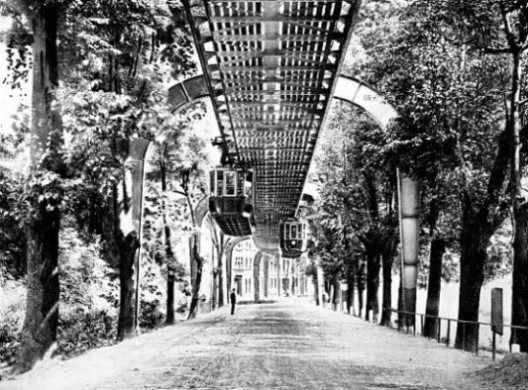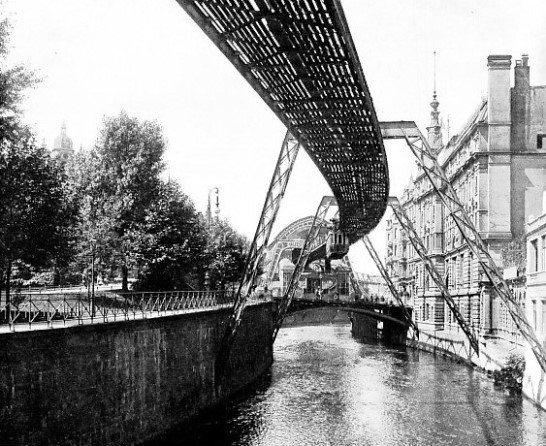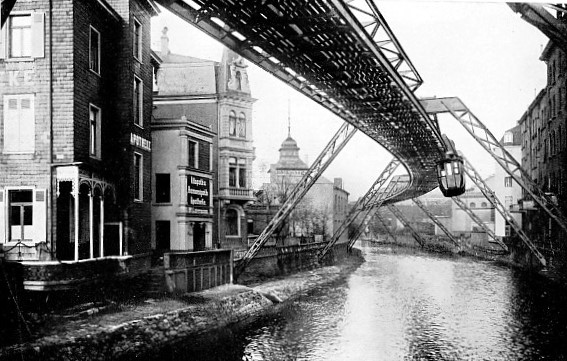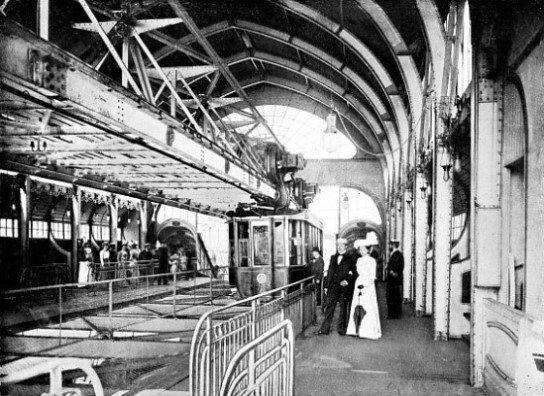
© Railway Wonders of the World 2024 | Contents | Site Map | Contact Us | Cookie Policy


The Langen Suspension Railway
The curious overhead line which runs between Elberfeld and Barmen -
THE INTERIOR OF DOEPPERSBERG STATION AT ELBERFELD, showing the method of suspending the car and the wire netting protection between platforms.
THE overhead railways common to New York and Chicago have been the butt of ridicule and joke since they first came into existence. But they have survived successfully the quips of the humorist, the fantastic delineations of the cartoonist, and the recriminations of the growler, inasmuch as they offer a successful solution of the intramural transportation question. The days when cinders and dirt descended upon horses, and when beads of oil fell down the necks of pedestrians below, have passed, because electric has supplanted steam working in accordance with the spirit of the age.
No one will deny that from the aesthetic point of view the overhead railway is an eyesore; it does not improve the beauty of an ugly street by any means. But that is not the issue. The public demands fast means of travelling from point to point in a busy centre, and in American cities preferred movement over an elevated track in broad daylight to transportation through a tube in darkness. Moreover, at the time the overhead system was brought into being, subterranean railway building was in its infancy, and the public, in the wisdom of its generation, preferred the proved to the problematical.
That the American overhead system possesses many disadvantages no one will deny. Subsequent knowledge evolved superior systems of overhead transportation, but even these have not enjoyed an extensive vogue. The most important of these is the Langen system, which works upon the mono-
The Langen system is a German invention, and is exemplified most potently in the stretch of line, nearly 8½ miles in length, connecting the two manufacturing towns of Elberfeld and Barmen. From the railway point of view it is a distinct novelty possessing many ingenious features. The permanent way comprises a system of latticed girders, one vertical and two longitudinal, which are assembled in such a way as to offer in section an I-
The track, properly so-
The permanent way is supported by massive frames springing from the ground, the shape of which varies according to the situation of the railway. Thus, where the line lies through the public streets an inverted U form of support is employed, so as to leave a clear headway for the full width of the thoroughfare. On the other hand, where the railway is built over the Wupper River, an A frame supersedes the inverted U used in the highways, the legs of the frame springing from either bank, so that the track is placed centrally above the waterway.
The span between each support varies according to the alignment of the line and the locality through which it passes, but the average is from 68¾ feet to 108¼ feet. The sharpest curves are about 300 feet radius. At intervals of 900 feet rigid double A-

THE SUSPENDED RAILWAY OVER A PUBLIC HIGHWAY. Showing the inverted U-
The cars are long, narrow vehicles, having tapered ends. They are 37½ feet in length by 6¾ feet wide and 8½ feet in height. Each vehicle has seating capacity for fifty passengers, and is provided with two doors opening inwardly in the sides, and doors at each end. In running order each car weighs 12 tons complete.
The carriage is suspended freely from two trucks spaced about 27 feet apart. Each truck is equipped with two wheels having double flanges, and mounted in tandem, thereby engaging with a single rail. Each truck is fitted with a 36-
Every precaution is adopted to ensure safety, and a derailment is impossible, even should a wheel or axle break, because the truck frames are carried round the track girder in the form of a hook. Play of only about a third of an inch is allowed, and in the event of a serious failure to the running wheels, the car is prevented from falling by the truck frames. Moreover, in running, oscillation of the car is limited severely, there being two projections on the lower part of the truck frames to prevent this movement. Consequently, travel, even at high speeds round the sharpest curves, is remarkably steady and free from swinging movement. In rounding the curves the cars assume a slightly inclined position, similar to that of the ordinary train under like conditions, but directly it enters a tangent, or section of straight track, the car reverts to the vertical position. The passengers, however, cannot perceive the slight inclination any more on this railway than upon the conventional line. Indeed, the inclination, even at the highest speeds upon the sharpest curves, is so very slight as to be practically imperceptible.
The stations are of special construction, being of the elevated type, with an arched roof. The platform is placed about 20 feet above the ground, so as to leave ample headroom for vehicular traffic in the street below. The platforms are approached by covered stairways similar to those adopted in the case of the American overhead railways, and the elevated sections of the London and provincial railways. Within the station, and extending throughout its entire length and width below the carriages, is stretched heavy wire netting for the protection both of passengers and those in the thoroughfares beneath.
Seeing that the cars are suspended, it might be thought that a considerable rocking motion would be set up by passengers entering and leaving the vehicles, but this is overcome in an ingenious manner. Beneath the cars a series of springs are mounted, and these bear upon longitudinal wooden beams, extending through the station and beneath the sides of the cars. Consequently, when weights become imposed upon the platform side of the car, inclination or rocking of the vehicle is obviated by the springs pressing against this wooden beam.
At the Zoological Gardens terminus of the railway the cars are transferred from the one line to the other — there are two tracks — in a novel and simple manner. A switch is moved, and the car, by means of a sharply descending rail, glides on to a second track beneath the main line, swings round a loop, and is brought on to the second track over a sharply ascending rail and a lifting switch. Thus the delays at the terminus are reduced to a minimum, the system being safer, quicker, and easier than would be the case were backing out and shunting adopted.
Elaborate precautions are observed to ensure safety in travelling. A block system working on the automatic track method is incorporated, wherein the signals are operated by the moving cars themselves. This arrangement enables the distance between two succeeding cars to be varied, according to the exigencies of the traffic, with very little difficulty. If desired, the distance between the vehicles can be reduced to two minutes, representing thirty trains per hour. The cars themselves are fitted with a Westinghouse air brake, a hand brake, and an electrical brake, so that ample facilities are carried for stopping the train. Should the emergency arise, these can be supplemented by reversing the motors.
Before this railway was built between Barmen and Elberfeld, an experimental line was laid down at Deutz, to demonstrate the features of the system, and its possibilities, as well as emphasising the safety of the principle. On this testing line the cars were driven at a speed as high as 47 miles per hour round the curves of 300 feet radius. When the Barmen-

THE RAILWAY ABOVE THE WUPPER RIVER IN ELBERFELD, showing the A-
Eighteen stations are disposed along the railway, and the trip of 8½ miles between Barmen and Elberfeld occupies about twenty-
Yet, despite the success of the Langen Railway in this instance, it has not been adopted elsewhere. Shortly after its completion the underground tube railway came into vogue, and as any overhead system is certain to entail a certain disfigurement of the streets as well as being attended by numerous other inconveniences, this form of transportation has given way to subterranean methods. Even in Germany the system has not undergone further development, recent overhead lines being carried out in accordance with orthodox designs.
But there is one other interesting expression of the Langen suspension idea in the land of its genesis. This is the Loschwitz mountain railway. It is not an exact replica of the Barmen-
This line runs from Loschwitz, a small village on the banks of the Elbe, some 5 miles from Dresden, to the top of Roehwitz Heights, whence a magnificent panoramic view of the neighbouring city is obtainable. It is only 820 feet from end to end, while the maximum grade is 1 in 3.
The overhead track is carried upon thirty-
The driving system also is different. Each car is attached to the end of a travelling cable, If inches in diameter, which passes round a large drum at the upper station, driven by two 80 horse-
This application of the Langen system, which was opened to the public in May, 1901, prompted Herr Feldmann to design the aerial cable way up the Wetterhorn, as described in the chapter “Aerial Mountain Railways”. As a matter of fact, it was responsible for the development of this type of mountain railway which now is being taken up so extensively. It was by no means a difficult evolution, seeing that the main difference between the two ideas is the utilisation of a flexible cable for the track, instead of a rigid rail, as advocated by Langen, the inventor.

CAR ROUNDING A 900 FEET CURVE AT HIGH SPEED.
You can read more on “Aerial Mountain Railways”, “Elevated and Mono-
